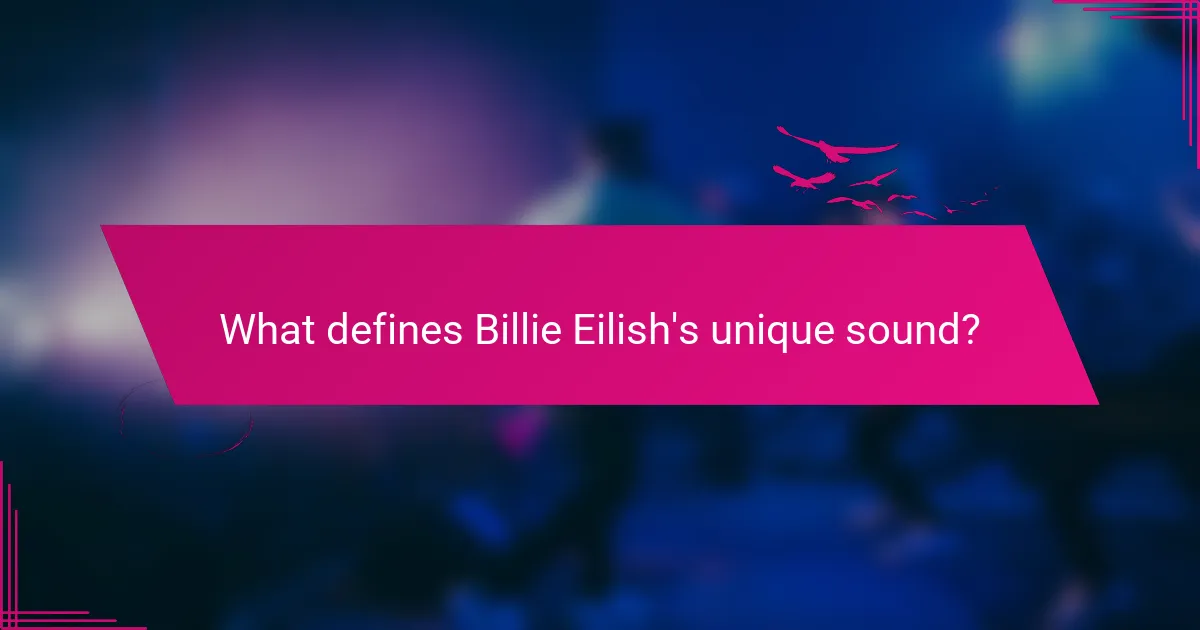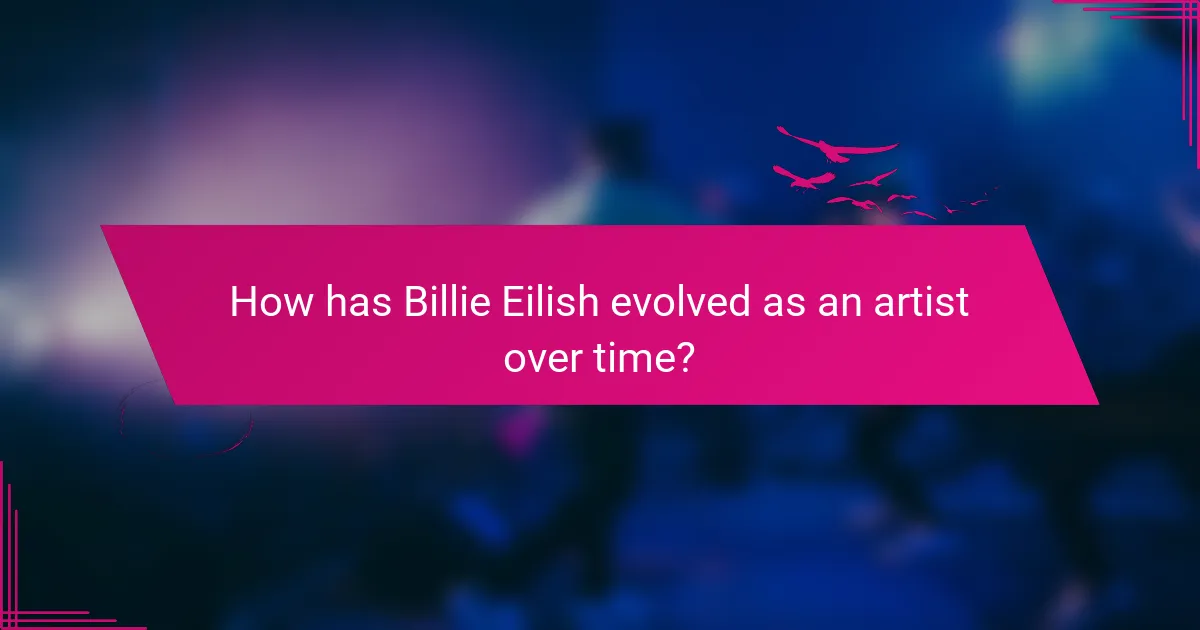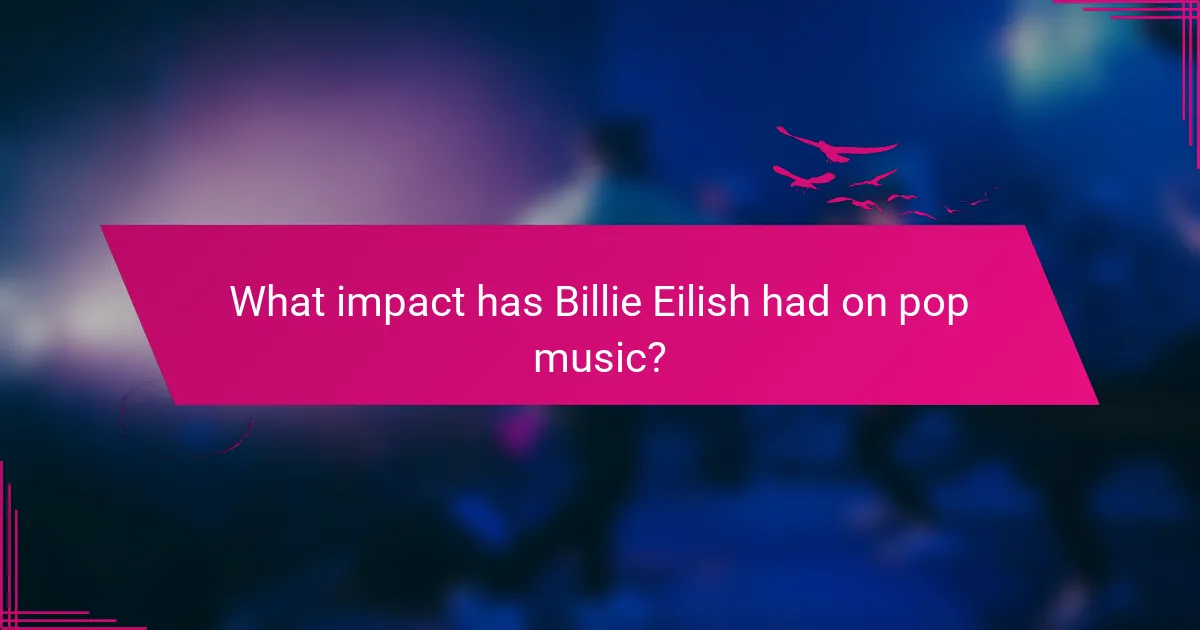Billie Eilish is a prominent pop artist known for her distinctive sound that merges pop, electronic, and alternative elements. Her music, characterized by minimalist production and soft, whispery vocals, often explores themes of mental health, identity, and personal experiences. Eilish’s debut album, “When We All Fall Asleep, Where Do We Go?”, achieved both critical acclaim and commercial success, marking a significant evolution in her artistic journey. Over time, she has transitioned from her early work, such as “Ocean Eyes” and the EP “Don’t Smile at Me,” to more complex and darker themes in her later projects. Eilish’s influence on the music industry is profound, as she has redefined pop music standards and inspired a new generation of artists.

What defines Billie Eilish’s unique sound?
Billie Eilish’s unique sound is defined by its blend of pop, electronic, and alternative elements. Her music features minimalist production, often created by her brother Finneas O’Connell. Eilish’s vocal style is characterized by soft, whispery tones and emotional delivery. The lyrics often explore themes of mental health, identity, and personal experiences. This combination creates an intimate atmosphere that resonates with listeners. Her debut album, “When We All Fall Asleep, Where Do We Go?” showcases these attributes, achieving critical acclaim and commercial success. Eilish’s distinct sound has influenced a new generation of artists in the pop music landscape.
How does Billie Eilish’s music blend different genres?
Billie Eilish’s music blends different genres through a unique combination of pop, electronic, and alternative influences. Her sound often incorporates elements of hip-hop, indie, and even classical music. This genre fusion creates a distinctive auditory experience. Eilish’s collaboration with her brother Finneas O’Connell enhances this blend. They experiment with unconventional song structures and production techniques. For instance, tracks like “Bad Guy” feature a minimalist beat paired with catchy melodies. Additionally, Eilish’s lyrical themes often explore darker subjects, contrasting with traditional pop. This eclectic approach has contributed to her widespread appeal and critical acclaim.
What are the key musical elements that contribute to her sound?
Billie Eilish’s sound is characterized by several key musical elements. These include her use of minimalist production, which creates an intimate atmosphere. Eilish often employs soft vocals paired with layered harmonies. Her music features unconventional song structures that defy traditional pop norms. Additionally, she incorporates a blend of genres, including pop, electronic, and alternative influences. The use of ambient sounds and textures adds depth to her tracks. Lyrically, she explores themes of vulnerability and introspection. Collaborations with her brother Finneas O’Connell contribute to her unique sound. Together, they create a distinctive sonic identity that resonates with a wide audience.
How do her vocal techniques enhance her unique style?
Billie Eilish’s vocal techniques enhance her unique style through their distinctiveness and emotive quality. She often employs breathy singing, creating an intimate atmosphere. This technique allows listeners to feel a personal connection to her music. Eilish frequently uses soft dynamics, which contrasts with the powerful themes of her lyrics. Her use of vocal layering adds depth and texture to her songs. Additionally, she incorporates whispered vocals, which evoke a sense of vulnerability. These techniques contribute to a signature sound that is both haunting and captivating. Her approach has influenced a new generation of artists, marking a shift in contemporary pop music.
In what ways does Billie Eilish’s lyrical content reflect her artistry?
Billie Eilish’s lyrical content reflects her artistry through its vulnerability and introspective themes. Her lyrics often explore personal experiences, mental health, and societal issues. This authenticity resonates with listeners, creating a deep emotional connection. Eilish employs vivid imagery and unique storytelling techniques in her songs. For instance, tracks like “Bellyache” and “When the Party’s Over” showcase her ability to convey complex emotions. Additionally, her use of conversational language makes her lyrics relatable. Eilish’s collaboration with her brother Finneas also enhances the depth of her lyrical content. Together, they craft songs that blend haunting melodies with poignant messages. This combination of elements establishes her distinctive voice in contemporary music.
What themes are commonly explored in her lyrics?
Billie Eilish commonly explores themes of mental health, identity, and relationships in her lyrics. Her songs often reflect struggles with anxiety and depression. Eilish addresses feelings of isolation and vulnerability. She also delves into complex relationships and emotional turmoil. The theme of self-discovery is prevalent in her work. Eilish’s lyrics frequently challenge societal norms and expectations. Additionally, she incorporates elements of darkness and introspection. These themes resonate with a wide audience, contributing to her impact on pop music.
How does her songwriting process influence her music?
Billie Eilish’s songwriting process significantly influences her music by emphasizing authenticity and emotional depth. She often collaborates with her brother Finneas O’Connell, which fosters a unique creative synergy. This collaboration allows for an intimate exploration of personal experiences and feelings. Eilish’s process includes writing lyrics that reflect her thoughts and emotions, making her songs relatable.
Furthermore, she utilizes minimalistic production techniques that enhance the lyrical content. This approach creates an atmospheric sound that complements her storytelling. Eilish’s songwriting often incorporates unconventional song structures, which keeps the listener engaged. Her willingness to experiment with different genres also broadens her musical appeal.
Overall, her distinct songwriting process shapes her music’s emotional resonance and innovative sound.

How has Billie Eilish evolved as an artist over time?
Billie Eilish has evolved significantly as an artist over time. She began her career in 2015 with the release of “Ocean Eyes.” This song showcased her ethereal voice and unique style. Eilish gained popularity quickly, leading to her debut EP “Don’t Smile at Me” in 2017. This project highlighted her introspective lyrics and genre-blending sound.
In 2019, she released her first full-length album, “When We All Fall Asleep, Where Do We Go?” This album marked a shift towards darker themes and experimental production. Eilish’s collaboration with her brother Finneas O’Connell became a defining element of her music.
Her subsequent work, including the James Bond theme “No Time to Die,” showcased her versatility. Eilish’s style has also evolved visually, reflecting her artistic growth. She has embraced bold fashion choices and distinctive aesthetics in her music videos.
Overall, Billie Eilish’s evolution as an artist includes a progression from a soft pop sound to a more complex and layered musical identity. Her impact on pop music continues to resonate through her innovative approach and authenticity.
What milestones mark her artistic journey?
Billie Eilish’s artistic journey is marked by several significant milestones. She gained initial recognition with her debut single “Ocean Eyes” in 2016. This track was released on SoundCloud and quickly went viral. Following this, her debut EP, “Don’t Smile at Me,” was released in 2017. It featured hits like “Bellyache” and “Idontwannabeyouanymore.” In 2019, Eilish won five Grammy Awards, including Album of the Year for “When We All Fall Asleep, Where Do We Go?” This achievement made her the youngest artist to win this award. Her 2021 album, “Happier Than Ever,” further showcased her artistic evolution. Eilish has also collaborated with various artists, including Khalid and Justin Bieber. Each of these milestones reflects her growth and impact on the music industry.
How did her debut album shape her career trajectory?
Billie Eilish’s debut album, “When We All Fall Asleep, Where Do We Go?”, significantly shaped her career trajectory. The album was released in March 2019 and debuted at number one on the Billboard 200 chart. It solidified her status as a leading figure in pop music. The album’s unique sound, characterized by its blend of pop, electronic, and indie elements, resonated with a broad audience. It featured hit singles like “Bad Guy,” which topped charts worldwide. The album won multiple Grammy Awards, including Album of the Year. This recognition expanded her fan base and increased her visibility in the music industry. Eilish’s distinct artistic style and personal lyrics set her apart from her peers. Overall, her debut album established her as an influential artist in contemporary music.
What changes in her music style have been noted in her subsequent releases?
Billie Eilish’s music style has evolved significantly in her subsequent releases. Initially, her sound was characterized by minimalist production and dark themes. In her later work, she incorporated a broader range of genres, including pop and electronic elements. Her vocal delivery has also shifted, becoming more dynamic and expressive. Additionally, her lyrics have explored more personal and complex topics. The production quality has improved, showcasing a more polished sound. Collaborations with various artists have introduced new influences into her music. Overall, these changes reflect her artistic growth and willingness to experiment.
How do her collaborations influence her artistic evolution?
Collaborations significantly influence Billie Eilish’s artistic evolution. They introduce her to diverse musical styles and perspectives. Working with various artists allows her to experiment with different genres. For instance, her collaboration with Finneas, her brother, shapes her signature sound. Collaborations also provide opportunities for creative growth and exploration. They expand her audience reach and enhance her artistic credibility. Each partnership contributes to her evolving identity as an artist. This dynamic interplay fosters innovation in her music and lyrics.
Which artists has she collaborated with, and what impact did these partnerships have?
Billie Eilish has collaborated with several artists, including Khalid, Justin Bieber, and Finneas O’Connell. Her partnership with Khalid on “Lovely” gained significant acclaim, showcasing her emotional depth and vocal range. This collaboration led to increased visibility for both artists, with the song reaching over a billion streams on Spotify. Eilish’s work with Justin Bieber on “Bad Guy (Remix)” further expanded her audience, blending their distinctive styles and drawing attention to her unique sound. Collaborating with her brother Finneas has been pivotal, as he co-writes and produces her music, creating a cohesive artistic vision that has redefined pop music. These partnerships have not only enhanced her artistic evolution but also solidified her impact on the genre, pushing boundaries and inspiring a new wave of musicians.
How do her influences shape her musical direction?
Billie Eilish’s influences shape her musical direction by blending various genres and personal experiences. Her music incorporates elements of pop, electronic, and alternative styles. Influences from artists like Lana Del Rey and Radiohead contribute to her atmospheric sound. Eilish’s personal struggles with mental health inform the emotional depth of her lyrics. Collaborations with her brother Finneas enhance her unique sound through innovative production techniques. The combination of these influences creates a distinctive identity in contemporary pop music. Her approach resonates with a generation seeking authenticity and vulnerability in art.

What impact has Billie Eilish had on pop music?
Billie Eilish has significantly influenced pop music through her unique sound and artistic approach. Her music blends various genres, including pop, electronic, and alternative. Eilish’s signature style features whispery vocals and minimalist production. This has shifted mainstream pop towards more introspective and experimental sounds.
Her debut album, “When We All Fall Asleep, Where Do We Go?” topped charts worldwide. It showcased themes of mental health and vulnerability, resonating with a younger audience. Eilish’s success has paved the way for other artists who embrace authenticity and emotional depth.
She has won multiple Grammy Awards, including Album of the Year in 2020. This recognition highlights her impact on the industry and her role in redefining pop music standards. Eilish’s influence extends beyond music to fashion and cultural conversations.
How has she changed the landscape of contemporary pop music?
Billie Eilish has transformed contemporary pop music through her distinctive sound and innovative approach. She incorporates elements of alternative, electronic, and indie genres into her music. Eilish often explores dark and introspective themes, which resonate with a younger audience. Her use of whispery vocals and minimalistic production sets her apart from mainstream pop artists. Collaborating with her brother Finneas, she creates a unique sonic palette that challenges traditional pop norms. Eilish’s success has influenced a wave of artists embracing authenticity and vulnerability in their work. Her album “When We All Fall Asleep, Where Do We Go?” debuted at number one on the Billboard 200, showcasing her impact on the charts. Eilish’s presence on social media has also redefined how artists engage with fans, emphasizing connection over polished images.
What role does her image play in her influence on the genre?
Billie Eilish’s image significantly shapes her influence on the pop genre. Her distinctive style, characterized by oversized clothing and bold colors, challenges traditional beauty standards. This visual identity resonates with her music’s themes of authenticity and vulnerability. Eilish’s image creates a relatable persona for her audience. It allows fans to connect with her on a personal level. Her presence in music videos and performances emphasizes her artistic vision. This consistency in image and sound reinforces her brand. Eilish’s influence is evident in how emerging artists adopt similar aesthetics.
How does her approach to music distribution and promotion differ from traditional methods?
Billie Eilish’s approach to music distribution and promotion significantly diverges from traditional methods. She utilizes digital platforms extensively, focusing on social media engagement rather than conventional marketing. Eilish often releases music directly to streaming services, bypassing traditional record label processes. This strategy allows for immediate access and global reach. Additionally, her promotion relies heavily on authentic connections with fans, often sharing personal stories and behind-the-scenes content. Traditional methods typically emphasize broad advertising campaigns and radio play. Eilish’s grassroots approach fosters deeper audience loyalty and interaction. This method has proven effective, as evidenced by her rapid rise in popularity and numerous awards, including multiple Grammys.
What are the reactions of critics and fans to her contributions to pop music?
Critics and fans have largely praised Billie Eilish’s contributions to pop music. Critics highlight her innovative sound and emotional depth in songwriting. Fans appreciate her authenticity and relatability in lyrics. Many reviews note her genre-blending style, which challenges traditional pop norms. Eilish has won multiple awards, including several Grammys, confirming critical acclaim. Social media reactions often express admiration for her unique aesthetic and live performances. Overall, her contributions have significantly influenced contemporary pop music trends.
How has her music been received by various demographics?
Billie Eilish’s music has been positively received across various demographics. Young listeners, particularly those aged 16 to 24, resonate with her relatable lyrics and unique sound. Her songs often address themes of mental health and self-acceptance, appealing to a generation facing these issues. Critics have praised her innovative production and vocal style, leading to multiple awards, including Grammy wins. Additionally, her collaborations with diverse artists broaden her appeal to older audiences. Eilish’s music has also gained traction in international markets, reflecting a global appreciation for her artistry. Overall, her ability to connect with different age groups and cultural backgrounds highlights her widespread influence in the music industry.
What awards and recognitions has she received that highlight her impact?
Billie Eilish has received numerous awards and recognitions that highlight her impact on music. She won five Grammy Awards in 2020, including Album of the Year for “When We All Fall Asleep, Where Do We Go?” This achievement made her the youngest artist to win this prestigious award. Additionally, she received the American Music Award for Favorite Soul/R&B Female Artist in 2020. Eilish was also awarded the MTV Video Music Award for Video of the Year for “Bad Guy.” Her influence is further recognized by her inclusion in Time magazine’s list of the 100 most influential people in the world in 2021. These accolades reflect her significant contributions to the music industry and her cultural impact.
What can aspiring artists learn from Billie Eilish’s journey?
Aspiring artists can learn the importance of authenticity from Billie Eilish’s journey. Eilish emphasizes staying true to oneself and creating music that reflects personal experiences. She gained recognition by sharing her vulnerabilities through her lyrics. Her unique sound, characterized by a blend of pop and alternative influences, showcases the value of innovation. Eilish’s success highlights the significance of building a strong online presence. She utilized platforms like SoundCloud and social media to connect with fans. Additionally, her collaborative work with her brother Finneas demonstrates the power of teamwork in the creative process. Eilish’s journey illustrates that perseverance and resilience are essential in overcoming challenges in the music industry.
Billie Eilish is the primary entity of this article, which explores her unique sound, artistic evolution, and significant impact on pop music. The article outlines her genre-blending style that incorporates pop, electronic, and alternative elements, alongside her minimalist production techniques and introspective lyrics. It details her collaborative work with her brother Finneas O’Connell, her notable milestones, and the themes prevalent in her music, such as mental health and identity. Additionally, the article highlights her influence on contemporary pop, her innovative approach to music distribution, and the critical acclaim she has received, including multiple Grammy Awards.